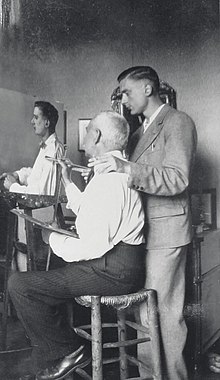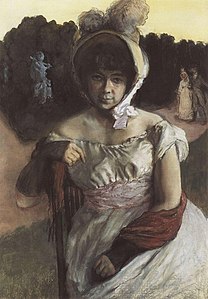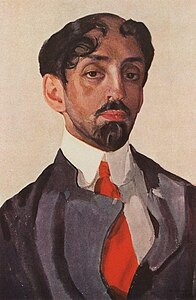| Revision as of 12:58, 16 August 2020 editArthistorian1977 (talk | contribs)Autopatrolled, Extended confirmed users, New page reviewers20,772 edits →After revolution← Previous edit | Revision as of 12:59, 16 August 2020 edit undoArthistorian1977 (talk | contribs)Autopatrolled, Extended confirmed users, New page reviewers20,772 edits →Private LifeTag: citing a blog or free web hostNext edit → | ||
| Line 45: | Line 45: | ||
| === Private Life === | === Private Life === | ||
| Somov was homosexual, like many of the ''World of Art'' members.<ref name="forgery">{{citation |title=Cultures of Forgery: Making Nations, Making Selves |first=Judith |last=Ryan |first2=Alfred |last2=Thomas |year=2003 |publisher=Routledge |isbn=0-415-96832-1 |page=151}}</ref> |
Somov was homosexual, like many of the ''World of Art'' members.<ref name="forgery">{{citation |title=Cultures of Forgery: Making Nations, Making Selves |first=Judith |last=Ryan |first2=Alfred |last2=Thomas |year=2003 |publisher=Routledge |isbn=0-415-96832-1 |page=151}}</ref> | ||
| In the last years of his studies, Somov who was already a well-known artist, led a very reclusive lifestyle. Judging by the letters from that period, loneliness was a burden for him. In the winter of 1899, Somov wrote to his friend and colleague Liza Zvantseva: “Unfortunately, I still have no romance with anyone - flirting is, perhaps, very light. But I'm tired of being without romance - it's time, otherwise life goes away and youth, and it becomes scary. I am terribly sorry that my character is heavy, boring, gloomy. I would like to be cheerful, light, so that everything is knee-deep, amorous and rip-off. Only such people have fun, interesting and not scared to live!". | In the last years of his studies, Somov who was already a well-known artist, led a very reclusive lifestyle. Judging by the letters from that period, loneliness was a burden for him. In the winter of 1899, Somov wrote to his friend and colleague Liza Zvantseva: “Unfortunately, I still have no romance with anyone - flirting is, perhaps, very light. But I'm tired of being without romance - it's time, otherwise life goes away and youth, and it becomes scary. I am terribly sorry that my character is heavy, boring, gloomy. I would like to be cheerful, light, so that everything is knee-deep, amorous and rip-off. Only such people have fun, interesting and not scared to live!". | ||
| Since 1910, his model Methodiy Lukyanov became his closest person. They lived together and he helped Somov to run the household, organize exhibitions. He was also his art advisor and critic of works. | |||
| In about 1930, Somov met Boris Mikhailovich Snejkovsky (born 23 July 1910), "the twenty-year old young man who would inspire several of Somov's best later works. He would sit for straightforward portrait drawings, beautiful, mildly suggestive oil paintings, and he may have been the model for more erotic watercolors. The exact nature of his relationship with his model and friend is unknown."<ref>{{cite web|url=http://godsandfoolishgrandeur.blogspot.com/2018/07/le-jeune-boris-portraits-of-boris.html|title=Le jeune Boris—portraits of Boris Snejkovsky by Konstantin Somov|last=O'Donnell|first=Stephen|date=2018-07-29|website=godsandfoolishgrandeur.blogspot.com/}}</ref> | |||
| == Legacy == | == Legacy == | ||
Revision as of 12:59, 16 August 2020
| This article or section is in a state of significant expansion or restructuring. You are welcome to assist in its construction by editing it as well. This template was placed by Arthistorian1977 (talk) 12:02, 16 August 2020 (UTC). If this article or section has not been edited in several days, please remove this template. If you are the editor who added this template and you are actively editing, please be sure to replace this template with {{in use}} during the active editing session. Click on the link for template parameters to use.
This article was last edited by Arthistorian1977 (talk | contribs) 4 years ago. (Update timer) |
| Konstantin Somov | |
|---|---|
 | |
| Born | (1869-11-30)November 30, 1869 Saint Petersburg |
| Died | May 6, 1939(1939-05-06) (aged 69) Paris |
| Education | Member Academy of Arts (1913) |
| Alma mater | Imperial Academy of Arts |
| Known for | Painting |
| Style | Modernism |
Konstantin Andreyevich Somov (Russian: Константин Андреевич Сомов; November 30, 1869 – May 6, 1939) was a Russian artist associated with the Mir iskusstva. Born into a family of a major art historian and Hermitage Museum curator Andrey Ivanovich Somov, he became interested in 18th-century art and music at an early age.
Biography
Early Life


Konstantin Somov was born on November 30, 1869 in St. Petersburg in the family of an art historian, famous museum figure, curator of the Hermitage Museum Andrei Somov. Konstantin was the second son in the family. His mother, Nadezhda Konstantinovna, who came from the noble family of the Lobanovs was a good musician and a well-educated person. She instilled in her children a love of theater, music and painting. In addition, the Somovs' house had a huge private collection of old prints, paintings and drawings. Painting and art were a constant subject of conversation and an integral part of their lives and young Konstantin dreamed of becoming an artist from a very young age.
For the first time Alexandre Benois met with Somov in the private gymnasium of Karl May. Dmitry Filosofov also studied there, and Somov found a common language and even became friends with him. Benoit in his memoirs says that their manner of sticking together, but apart from everyone else, but for some reason attracted Benoit himself. Later, Dmitry Filosofov was sent to Italy due to illness, and Somov, who had a hard time studying science, was taken from the gymnasium by his father. At the age of 20, Konstantin Somov entered the Imperial Academy of Arts. He studied their under Ilya Repin from 1888 to 1897. While in academy, Benois introduced him to Sergei Diaghilev and Léon Bakst. When the three founded the World of Art, Somov liberally contributed to its periodicals.
Studying in the academy is not easy for Somov, but in 1897 he successfully completed it and moved to Paris to continue his education at the legendary Académie Colarossi.
Inspired by Watteau and Fragonard, he preferred to work with watercolours and gouache. For three years he worked upon his masterpiece, Lady in Blue, painted in the manner of 18th-century portraitists.
The artist's first serious success came a year before graduation from the Academy. Somov and Benois spent the summer of 1896 at their dacha near Oranienbaum, in the village of Martyshkino. The landscapes and sketches he brought from there were highly praised by critics and colleagues from the academic environment. In the same summer, he creates illustrations for the works of Ernst Theodor Amadeus Hoffmann.
During the 1910s, Somov executed a number of rococo harlequin scenes and illustrations to the poems by Alexander Blok. Many of his works were exhibited abroad, especially in Germany, where the first monograph on him was published in 1909.
After revolution
Somov, like many of his contemporaries, greeted the revolution in Russia with enthusiasm. But living conditions gradually deteriorated: at first, his apartment was nationalized, and at the end the artist was completely evicted from it. Only by a miracle he managed to defend the rights to his own works.
In December 1923, Konstantin Somov, together with the Russian Exhibition, went to the United States as an authorized representative of Petrograd. In the USA, he becomes close to the family of Sergei Rachmaninoff and paints portraits of the composer and his daughter. He never returned to his homeland, forever remaining in France. Somov found Soviet Russia "absolutely alien to his art" and moved to Paris. There, a community of Russian émigré artists had developed by this time. Somov found inspiration in "world of artists" living in Paris - his old friend Benoit, Bakst and Serebryakova.
Somov was buried at the Sainte-Geneviève-des-Bois Cemetery.
Private Life
Somov was homosexual, like many of the World of Art members.
In the last years of his studies, Somov who was already a well-known artist, led a very reclusive lifestyle. Judging by the letters from that period, loneliness was a burden for him. In the winter of 1899, Somov wrote to his friend and colleague Liza Zvantseva: “Unfortunately, I still have no romance with anyone - flirting is, perhaps, very light. But I'm tired of being without romance - it's time, otherwise life goes away and youth, and it becomes scary. I am terribly sorry that my character is heavy, boring, gloomy. I would like to be cheerful, light, so that everything is knee-deep, amorous and rip-off. Only such people have fun, interesting and not scared to live!".
Since 1910, his model Methodiy Lukyanov became his closest person. They lived together and he helped Somov to run the household, organize exhibitions. He was also his art advisor and critic of works.
In about 1930, Somov met Boris Mikhailovich Snejkovsky (born 23 July 1910), "the twenty-year old young man who would inspire several of Somov's best later works. He would sit for straightforward portrait drawings, beautiful, mildly suggestive oil paintings, and he may have been the model for more erotic watercolors. The exact nature of his relationship with his model and friend is unknown."
Legacy
On June 14, 2007, Somov's landscape "The Rainbow" (1927) was sold at Christie's for US$7.33 million, a record for a work at an auction of Russian art.
Somov's diary (Dnevik) for the years 1917-1925 was published in Russian by Dmitrii Sechin (Moscow) in 2017 and 2018; the two volumes total over 1600 pages.
Works
-
 A. K. Benois (1896)
A. K. Benois (1896)
-
 Vyacheslav Ivanov's Cor Ardens (1907)
Vyacheslav Ivanov's Cor Ardens (1907)
-
 A Ridiculed Kiss (1908)
A Ridiculed Kiss (1908)
-
 Mikhail Kuzmin (1909)
Mikhail Kuzmin (1909)
-
 Alexander Blok's Theatre (1909)
Alexander Blok's Theatre (1909)
-
 La Petite Langue de Colombine (1915)
La Petite Langue de Colombine (1915)
-
 Illustration for The Book of the Marquise ("Книга маркизы") (1918)
Illustration for The Book of the Marquise ("Книга маркизы") (1918)
-
 Sergei Rachmaninoff (1925)
Sergei Rachmaninoff (1925)
-
 Open door onto a garden
Open door onto a garden
-
 Portrait of a Woman
Portrait of a Woman
-
 A Reclining Man
A Reclining Man
See also
References
- "Konstantin Somov Online". Artcyclopedia.com. Retrieved 2012-04-16.
- "Константин Сомов: тёмная, холодная, старая страсть". regnum.ru. Retrieved 2020-08-16.
{{cite web}}:|archive-date=requires|archive-url=(help) - "Романтик ушедшей эпохи: Константин Сомов". VTB. Retrieved 2020-08-16.
- Ryan, Judith; Thomas, Alfred (2003), Cultures of Forgery: Making Nations, Making Selves, Routledge, p. 151, ISBN 0-415-96832-1
- O'Donnell, Stephen (2018-07-29). "Le jeune Boris—portraits of Boris Snejkovsky by Konstantin Somov". godsandfoolishgrandeur.blogspot.com/.
- Varoli, John (2007-06-14), "Russian Sale Sets Record, 'Crazy' Prices at Christie's, London", Bloomberg, retrieved 2007-09-20
- Members of the Imperial Academy of Arts
- Imperial Academy of Arts alumni
- 1869 births
- 1939 deaths
- Gay artists
- LGBT artists from Russia
- LGBT people from Russia
- 19th-century Russian painters
- Russian male painters
- 20th-century Russian painters
- Russian watercolorists
- Russian illustrators
- Painters from Saint Petersburg
- Art Nouveau painters
- Burials at Sainte-Geneviève-des-Bois Russian Cemetery
- Imperial Russian emigrants to France
- Imperial Russian emigrants to the United States